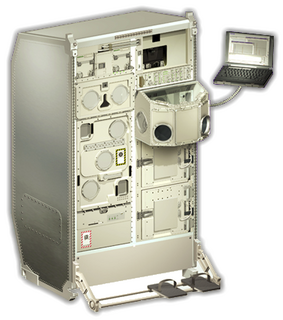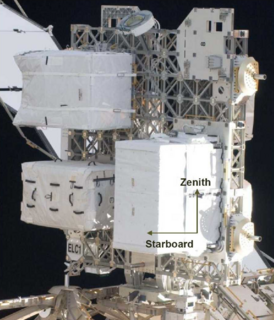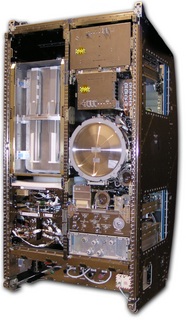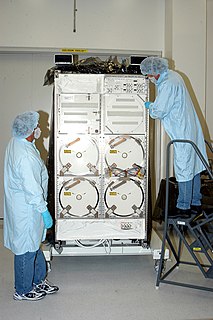 W
W2001: A Space Travesty is a 2000 sci-fi comedy film directed by Allan A. Goldstein and starring Leslie Nielsen, Ophélie Winter, Peter Egan, and Ezio Greggio. The film has a few sequences parodying elements of 2001: A Space Odyssey, but is not focused on parodying that film alone. Filming took place in Los Angeles, California.
 W
WThe Advanced Resistive Exercise Device (ARED) is an exercise device designed by NASA to allow for more intense workouts in zero gravity. The device was flown to the International Space Station during STS-126 and installed in 2009 to replace its inefficient predecessor, the Interim Resistance Exercise Device. The device uses a system of vacuum tubes and flywheel cables to simulate the process of free weight exercises, such as squats, deadlifts, and calf raises, workouts which more effectively prevent lower muscle atrophy, though it has the capability to workout any muscle group. The ARED device can accommodate all astronauts on the ISS.
 W
WBiolab is a single-rack multi-user science payload designed for use in the Columbus laboratory of the International Space Station. Biolab support biological research on small plants, small invertebrates, microorganisms, animal cells, and tissue cultures. It includes an incubator equipped with centrifuges in which the preceding experimental subjects can be subjected to controlled levels of accelerations.
 W
WThe Columbus External Payload Facility (Columbus-EPF) is a component of the Columbus module on the International Space Station. It consists of two identical L-shaped consoles attached to the starboard cone of Columbus in the zenith (top) and nadir (bottom) positions, each supporting two platforms for external payloads or payload facilities. Four external payloads can be operated at the same time.
 W
WThe Combustion Integrated Rack (CIR) is an experiment facility installed in the International Space Station (ISS). It includes an optics bench, combustion chamber, fuel and oxidizer control, and five different cameras for performing combustion experiments in microgravity.
 W
WThe European Drawer Rack (EDR) is a single, six-post International Standard Payload Rack (ISPR) with seven Experiment Modules (EMs), each of which has separate access to power and cooling. A video management unit sends streaming video, images, and science data to Earth via the Columbus module's high-rate data link and can temporarily store 72 GB of video. The experiments are largely autonomous to minimize data transfer requirements, though the EDR can be operated remotely via telescience or in real time by the crew via a dedicated laptop. The EDR has two different types of EMs: the standard International Space Station locker and the standard eight panel unit International Subrack Interface Standard (ISIS) drawer.
 W
WThe European Physiology Module (EPM) is an International Standard Payload Rack for the Columbus Laboratory on board the International Space Station. The EPM rack was built by OHB-System in Bremen.
 W
WThe European Technology Exposure Facility (EuTEF) was a payload mounted on the exterior of the European Columbus laboratory, one of the modules of the International Space Station. The facility, mounted onto the exterior of Columbus, provided a platform for multiple types of experiments and materials to be exposed directly to the harsh space environment.
 W
WThe European Transportation Carrier (ETC) transports various payload items, such as commissioning items, science instruments, consumables, orbital support equipment, orbital replacement units, and resupply items, and science items, such as containers. This applies especially to European payload items that cannot be launched in their payload's rack due to limited stowage and transportation capabilities. On orbit, the ETC serves as a workbench and stowage facility, supporting the Biolab, Fluid Science Laboratory (FSL), European Physiology Module (EPM), and European Drawer Rack (EDR).
 W
WAn EXpedite the PRocessing of Experiments to Space Station (ExPRESS) Logistics Carrier (ELC) is an unpressurized attached payload platform for the International Space Station (ISS) that provides mechanical mounting surfaces, electrical power, and command and data handling services for Orbital Replacement Units (ORUs) as well as science experiments on the ISS. The ELCs were developed primarily at the Goddard Space Flight Center in Greenbelt, Maryland, with support from JSC, KSC, and MSFC. ELC was formerly called "Express Pallet" and is the unpressurized counterpart to the pressurized ExPRESS Rack. An ELC provides scientists with a platform and infrastructure to deploy experiments in the vacuum of space without requiring a separate dedicated Earth-orbiting satellite.
 W
WThe Fluid Science Laboratory is a European (ESA's) science payload designed for use in Columbus built by Alenia Spazio, OHB-System and Verhaert Design and Development. It is a multi-user facility for conducting fluid physics research in microgravity conditions. It can be operated in fully or in semi-automatic mode and can be controlled on board by the ISS astronauts, or from the ground in the so-called telescience mode.
 W
WHuman Research Facility 1 (HRF-1) on board the International Space Station (ISS) allows investigators to study the effects of long-duration space flight on the human body. Equipment in the HRF-1 includes a clinical ultrasound and a device for measuring mass.
 W
WThe Human Research Facility Holter Monitor (Holter) is a battery-powered, noninvasive electrocardiogram (ECG) device that accurately measures the heart rate of crew members over an extended period of time. ECG information is stored on a Portable Computer Memory Card International Adapter (PCMCIA) card and downlinked to Earth for analysis after monitoring is complete.
 W
WThe Materials Science Laboratory (MSL) of the European Space Agency is a payload on board the International Space Station for materials science experiments in low gravity.
 W
WThe Microgravity Science Glovebox (MSG) was a glovebox aboard the International Space Station. It provided a safe contained environment for research with liquids, combustion and hazardous materials in the microgravity conditions of the ISS. Without the MSG, many types of hands-on investigations would be impossible or severely limited on board the Station. The Microgravity Science Glovebox (MSG) occupied a floor-to-ceiling rack inside the Destiny module of the International Space Station (ISS). It is more than twice as large as gloveboxes flown on the Space Shuttle and could contain larger investigations that are about twice the size of an airline carry-on bag. . A follow on sister facility, managed by the same group at Marshall Space Flight Center, is intended to further support biological experiments with the Life Science Glovebox.
 W
WThe Minus Eighty-Degree Laboratory Freezer for ISS (MELFI) is a European-built experiment storage freezer for the International Space Station. It comprises four independent dewars which can be set to operate at different temperatures. Currently temperatures of −80 °C, −26 °C, and +4 °C are used during on-orbit ISS operations. Both reagents and samples will be stored in the freezer. As well as storage the freezer is designed to be used to transport samples to and from the ISS in a temperature controlled environment. The total capacity of the unit is 300 litres.
 W
WThe Muscle Atrophy Research and Exercise System (MARES), part of the Human Research Facility (HRF), was launched on 5 April 2010 (STS-131) in a stowed position inside the HRF MARES Rack, integrated into a Multi-Purpose Logistics Module (MPLM) and transported to the International Space Station. When deployed, MARES was attached to the seat tracks of an International Standard Payload Rack (ISPR) located in the Columbus Laboratory.
 W
WThe Plasmakristall-3 Plus laboratory was a joint Russian-German laboratory for the investigation of dusty/complex plasmas on board the International Space Station (ISS), with the principal investigators at the German Max Planck Institute for Extraterrestrial Physics and the Russian Institute for High Energy Densities. It was the successor to the PKE Nefedov experiment with improvements in hardware, diagnostics and software. The laboratory was launched in December 2005 and was operated for the first time in January 2006. It was used in 21 missions until it was deorbited in 2013. It is succeeded by the PK-4 Laboratory.
 W
WSOLAR was an ESA science observatory on the Columbus Laboratory, which is part of the International Space Station. SOLAR was launched with Columbus on February 2008 aboard STS-122. It was externally mounted to Columbus with the European Technology Exposure Facility (EuTEF). SOLAR has three main space science instruments: SOVIM, SOLSPEC and SOL-ACES. Together they provide detailed measurements of the Sun's spectral irradiance. The SOLAR platform and its instruments are controlled from the Belgian User Support and Operations Centre (B.USOC), located at the Belgian Institute for Space Aeronomy (BISA) in Uccle, Belgium.
 W
WThe Treadmill with Vibration Isolation Stabilization System, commonly abbreviated as TVIS, is a treadmill for use on board the International Space Station and is designed to allow astronauts to run without vibrating delicate microgravity science experiments in adjacent labs. International Space Station treadmills, not necessarily described here, have included the original treadmill, the original TVIS, the БД-2, the Combined Operational Load-Bearing External Resistance Treadmill (COLBERT), and the Treadmill 2. Some share a name, some a design, some a function, some use different (passive) vibration-suppression systems, some it is unclear how they differ.
 W
WThe Window Observational Research Facility (WORF) is an experiment rack facility manufactured by the Brazilian Space Agency, which remotely operated payloads and crew members can perform Earth and space science research, including hand held photography, at the U.S. Laboratory Science Window on the International Space Station. WORF is based on an International Standard Payload Rack (ISPR) and utilizes avionics and hardware adapted from the EXPRESS Rack program. The rack provides a payload volume equivalent to 0.8 m3 (28 cu ft), and will be able to support up to three payloads simultaneously, depending on available resources and space available at the window. The WORF will also provide access and equipment for crew Earth observations, such as crew restraints, camera/camcorder brackets, and condensation prevention. WORF payloads include those focusing on geology, agriculture, ranching, environmental and coastal changes, and education.